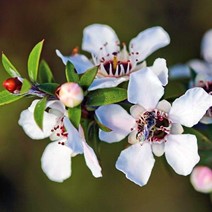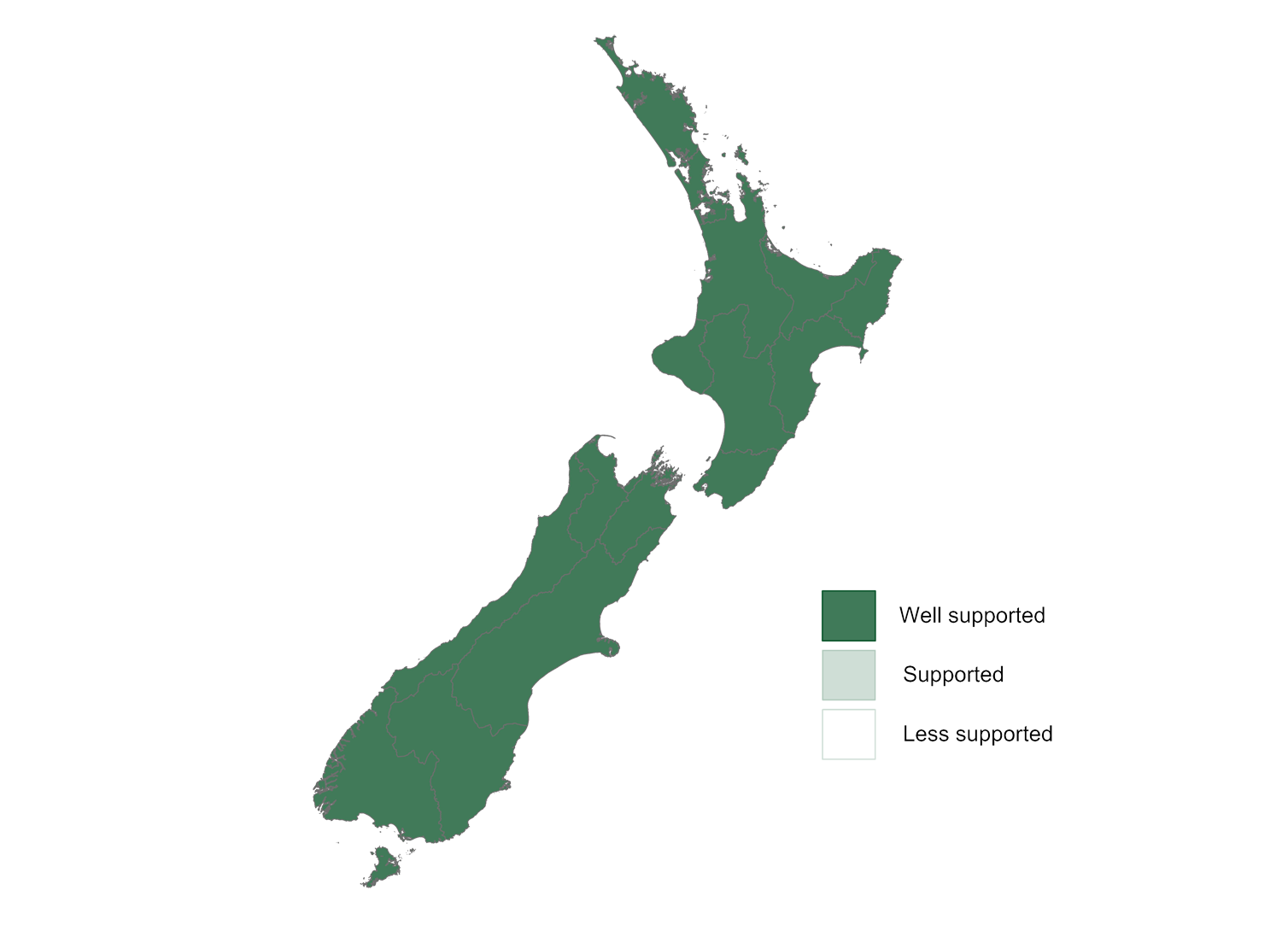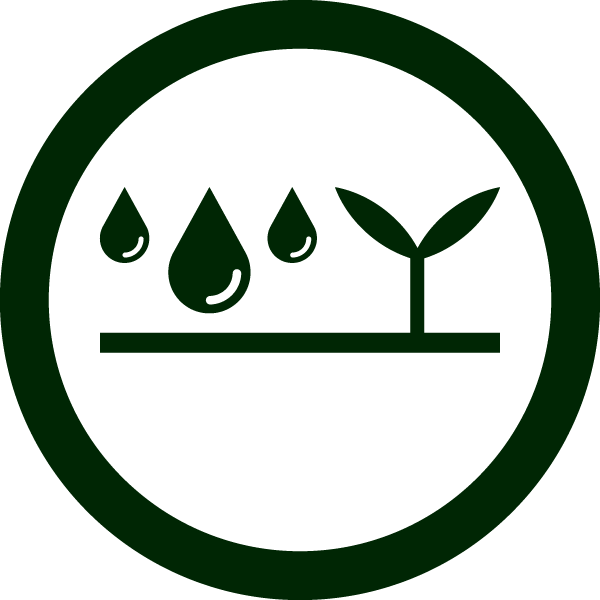
Land use fact sheet
Mānuka for honey or oil
Mānuka is one of the most abundant New Zealand native shrubs. It is a fast growing, conical-shaped bush that can range from creeping matted plants to trees reaching 8m high. Local varieties can have different shaped leaves, and flowers can be different sizes and colours.
Plantations are either used for honey or for oil, because harvesting for oil prevents the plant from flowering.
Mānuka oil
Mānuka oil is produced by steam distillation of the shrub’s leaves. It contains a range of naturally occurring organic compounds collectively known as Mānuka beta-triketones (MβTK™). These compounds have very high antimicrobial properties.
Mānuka honey
Mānuka honey contains a chemical called methylglyoxal (MGO), which is what gives it its famed antibacterial properties. MGO is slowly converted from another compound, called DHA, as honey matures.
MGO, DHA and a third compound, Leptosperin, are the three markers that are used to calculate the UMF, or Unique Mānuka Factor of the honey. The higher the UMF the more valuable the honey.
 Overview
Overview
Regions
Mānuka is common in NZ’s lowland to low alpine regions. About 80% of NZ's mānuka oil is produced around East Cape.
Growing conditions
Mānuka grows well in areas it has grown in the past. Feral pests are a major threat and need managing until establishment.
Climate
Mānuka prefers north facing slopes although young seedlings will be susceptible to frost until established.
Commercial scale
Commercial scale starts at 50 hectares and depends on the volume and quality of the resource you are harvesting.
Getting started
You could be producing honey under a range of different agreements or oil at enough scale to process and pay for machinery.
Skills / employment
Honey and oil plantations are very different. You may need beekeeping or machine harvesting and processing capabilities.
 Regions
Regions
Mānuka is common throughout New Zealand in lowland to low alpine regions up to 1800m above sea level.
Around 80% of New Zealand's mānuka oil is produced around East Cape, on land that is suitable for the use of machine harvesters. Mānuka honey can be collected throughout NZ.
Get a report on your whenua
Enter the details of your whenua into our search to create a downloadable report showing information about the environment, economy, and climate in your region — and the potential that creates for development.

 Commercial scale
Commercial scale
There is no written rule for commercial scale of a mānuka plantation although generally the larger the plantation the better. Initial plantations started at 20ha and quickly increased to 50ha or more.
Larger plantations exceeding 100ha are now being considered, including conversion of sheep and beef farms. Smaller blocks can consider partnering with a beekeeper.
 Getting into the industry
Getting into the industry
Mānuka will thrive in almost all land types from geothermal areas and wetlands, to dunes and dry hill slopes.
Mānuka honey
Producing mānuka honey requires a plantation site and flowering season with specific conditions to maximise bee foraging and limit nectar dilution, while maintaining hive health.
You'll get best results from plantation sites that:
- are larger than 100ha
- are north facing
- have a moderate climate during flowering.
The ideal site is a steep sided valley with good road access along ridges and valley floor.
There are different ways landowners can partner with beekeepers and honey companies for harvesting, processing and selling. The most common arrangements are:
- Fixed price contract, usually per hive. This tends to be the more common approach for naturally occurring mānuka resource where UMF is typically low.
- Fixed price contracts based on production. This can have a fixed base rate, plus extra compensation depending on how much honey is produced or it can be a straight fixed price per kilogram of production.
- Proportion of total earnings from honey produced. This can have a base component too. It means you get paid for the amount of honey produced, and more or less depending on the quality and price movements in market.
- Plantation collectives. Some mānuka plantation owners are forming collectives (particularly on Maori-owned land) and developing contractual arrangements with beekeepers allowing the group to retain, brand and market their own honey, while providing the beekeeper a proportion of the honey yield. This allows plantation owners to increase returns by selling honey at retail prices rather than wholesale prices. However it also means the collective must invest in skilled staff, honey storage, packaging, branding, and finding retail outlets.
Mānuka oil
Oil can only be produced from land which has a suitable contour for machine harvesting of the branches. You will need to either own or be able to access a mechanical harvester. It may be possible to hire a contractor or to work with another nearby grower to get access.
Oil produced in different regions varies in MβTK™ levels, which vary in concentration depending on many factors including soil, climate, location, ecological environment and seasonal variations. Around 80% of New Zealand's mānuka oil is produced around East Cape.
Sourcing seedlings
In some areas eco-sourcing, or selecting varieties that are local is preferred.
Specially sourced varieties that have been selected for specific properties can also be accessed through businesses like Mānuka Farming NZ.
Establishing the trees
A large percentage of seedlings will die after planting. The higher the percentage of seedlings that survive, the lower your costs and the faster your plantation will become established. Seek expert advice on the suitability of your site the variety you plant — there may be more than one. The consultant will also help with plantation design and establishment.
The site should be prepared and planted according to the agreed design. You'll need to focus on controlling and eradicating weeds and pests in the first two years.
Keep monitoring the seedlings after planting to identify trees that have died and need to be replaced. This is called a survivability survey. The cost of monitoring and of the replacement seedlings should be factored into the establishment budget.
 Skills and employment
Skills and employment
You'll need labour to plant the trees, monitor for pests and carry out survivability surveys until the plantation is established.
The activities on a honey plantation vs an oil plantation are very different. Plantations are either used for honey or for oil, because harvesting for oil prevents the plant from flowering.
Honey
If the landowner owns their own hives, activities include beekeeping, hive husbandry and harvesting and processing of the honey. These are skilled activities that require training and proper supervision for a successful operation.
Oil
In an oil plantation, brush must be harvested using a mechanical harvester then distilled to produce mānuka oil. Labour is needed during the harvest and processing activities.
 Compliance
Compliance
Beekeeping
Hive owners must register their hives and apiary sites and pay levies to the Ministry for Primary Industries for government surveillance and regulatory programmes. Apiculture New Zealand has more information about beehive compliance on their website.
Erosion, runoff and sediment control
High density mānuka is very effective at erosion control, maintaining the stability of steep slopes that typically slip when in pasture and reducing sediment runoff.
Mānuka is more effective than pasture or crops at filtering surface water runoff. It helps to protect stream habitats by stabilising the stream bank (riparian margin) and shading the waterway. In these ways mānuka can improve water and habitat quality over time.
Emissions Trading Scheme (ETS)
Landowners can earn New Zealand Units (NZUs), commonly known as carbon credits, for any forest first established after 31 December 1989. NZUs are earned by entering the Emissions Trading Scheme (ETS). To be eligible, the forest must:
- be at least one hectare
- be at least 30m wide on average
- have tree crown cover of at least 30% in each hectare
- contain trees which have the potential to reach a minimum of 5m height at maturity in the place they are located.
 Growing conditions
Growing conditions
Mānuka can grow in areas of very low soil fertility and even rock crevices but grow at highest rates in fertile soils, that are well drained and have a neutral pH. Mānuka stands establish well in areas that have grown mānuka in the past.
Although they're hardy when mature, young seedlings are still susceptible to frost. When establishing a new plantation it's important to ensure the seedlings are sufficiently "hardened" before planting, particularly if they have come from an indoor nursery.
Seedlings are vulnerable to pests such as wild goats, hares and rabbits. It's common practice to employ a professional hunter to eradicate pests before the seedlings are planted. They may be required to return from time to time. Consider avoiding areas where feral pests are difficult or impossible to control.
Competition with weeds and grasses must also be considered. This can be mitigated by spraying before and after planting.
 Climate
Climate
Mānuka requires full sunlight to grow and germinate. Plants on north-facing slopes grow slightly faster and have more flowers than those grown on south facing slopes, which is good for honey production.
Once established the mānuka can withstand hard frost.
 Water
Water
Mānuka plantations don't need irrigation.
 Market
Market
Honey
Hive numbers in New Zealand have been growing at 10% per year since 2007. Honey production has nearly doubled in a little over a decade.
Total New Zealand honey exports now top $350 million a year and mānuka honey accounts for 70-75% of the total value. This excludes medical-grade product and packaged products where mānuka honey has been used as an ingredient in a food, health or cosmetic product.
New Zealand mānuka honey offers superior quality, trustworthiness, brand power and unique attributes. New Zealand honey receives a price multiple that is 7 to 9 times higher than most other exporting countries.
The largest market for NZ honey is the USA (20%) but the demand from China is growing rapidly.
 Future industry
Future industry
Demand for mānuka health products currently outweighs supply so there is potential for growth in the industry. Plant research and breeding is currently focused on:
- identifying and growing mānuka cultivars with high levels of DHA, which converts to the antibacterial compound MGO as the honey matures
- greater nectar volumes and more flowers.
On an environmental front mānuka shows excellent potential (significantly more than pasture) for erosion control.
 Operational costs
Operational costs
Establishing a mānuka stand starts from around $2,500 to $3,000 per hectare. This covers weed removal, seedlings, post-planting weed control, monitoring, infill planting and pest management costs.
If the site is challenging it can cost a lot more.
 Grower returns
Grower returns
Honey
Mānuka honey yields are variable ranging from 15-52kg per hive per season, with an average of around 23kg per hive. Industry best practice is one hive per hectare of mānuka plantation.
Mānuka honey prices depend mainly on UMF®/MGO content, ranging from $16/kg for low UMF®/MGO honey to $60+/kg for high UMF®/MGO honey.
Net cash returns for mānuka honey are normally around $1,000 per hectare by year 7 and a stand has a productive life of 20 years for honey production if skilfully managed. If there is less active management then income is usually restricted to years 3 and 15, with maximum yields at years 6 and 7 following planting.
Oil
Foliage from the North Island’s East Coast, Coromandel and Great Barrier Island can produce 3-5 litres of oil per tonne of foliage. For generic mānuka oil, wholesale prices are around $500-600 per kg and oil production costs are around $400-450 per kg, but these values vary depending on oil properties and factors such as harvesting costs.
 Seek advice
Seek advice
Seek advice early, before you invest in any design or development.
Talk to your local Te Puni Kōkiri office to see how they can support you through your decision-making process. They will be able to provide advice and find out whether your project qualifies for funding.
If possible, seek out advice from people who grow mānuka for honey or oil in your area as well as knowledgeable suppliers.
Talk to qualified consultants who are experienced in beekeeping, mānuka and other plantation forestry, and other land developments in your area. They will be able to provide detailed, impartial advice on what will (and won't) work on your whenua.
 About this fact sheet
About this fact sheet
This fact sheet provides general information to help start and inform conversations. It is not comprehensive enough to support detailed decision-making.
The information in this fact sheet has been contributed by AgFirst and Te Puni Kōkiri kaimahi. Data that has not been credited in the body of the fact sheet has been sourced from StatsNZ or provided by the contributors.
You can provide feedback on the content on this or any fact sheet by emailing the Whenua Māori Service at whenuainfo@tpk.govt.nz